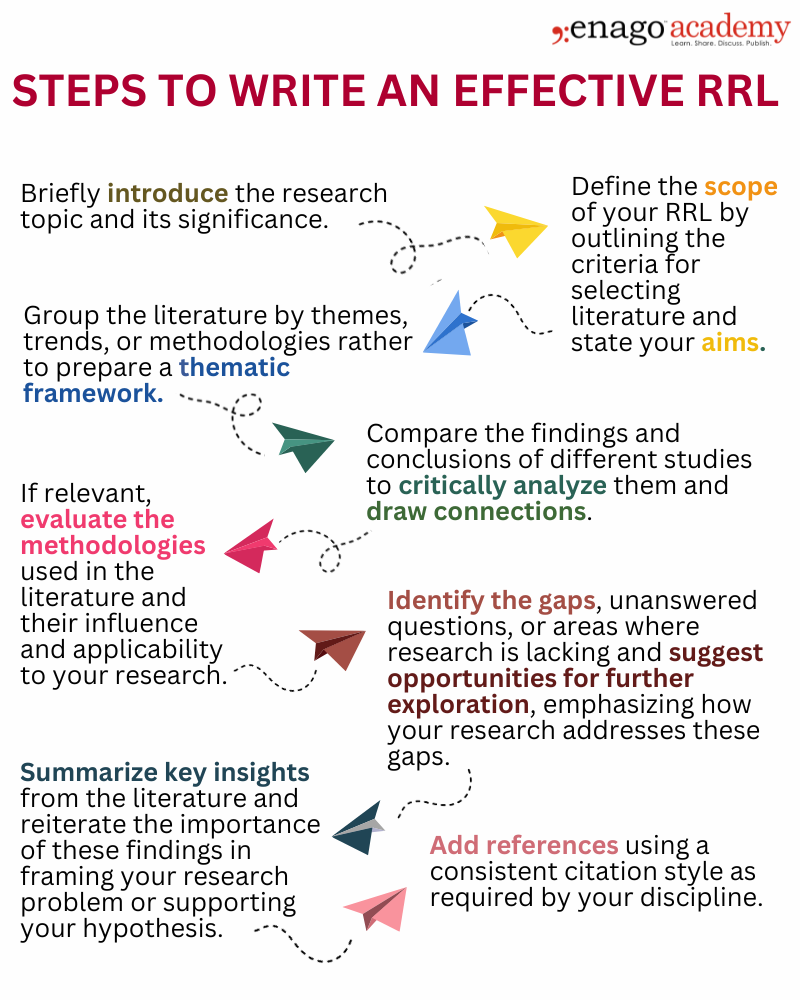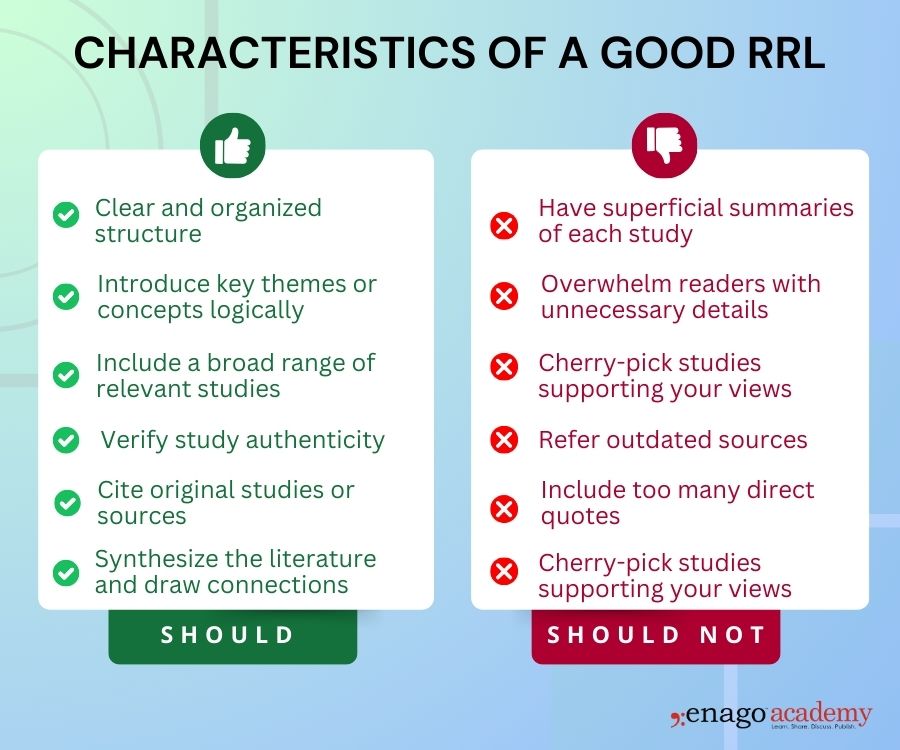What is RRL in Research? Definition, Tips, and More!

Tina, a first-year doctoral student, nervously scrolled through some research articles. She had just received her first major assignment: writing a comprehensive Review of Related Literature (RRL). The task seemed daunting, and questions swirled in her mind. What is an RRL? How is it different from a simple summary of studies?
Does Tina’s journey toward understanding RRL sound familiar to you? Let’s understand RRL for tackling it with confidence!
What is an RRL in Research?
Tina’s first step was to understand what RRL truly meant. After consulting her mentor and reading a few resources, she learnt:
A Review of Related Literature (RRL) is a comprehensive and critical evaluation and summary of previous research relevant to a specific topic. It goes beyond summarizing studies to identify trends, gaps, and connections in the existing literature, setting the foundation for a new study. RRL is important in research as it:
Having grasped the essence of RRL, Tina realized there was more to learn. During a seminar, she encountered another term: RRS (Review of Related Studies). She misunderstood RRS to be the same as RRL. However, as she read further, she understood RRL differed from RRS.
RRL vs. RRS: Understanding the difference
The first thought that crossed Tina’s mind was “What is RRS?” As she read further, she understood that RRS is a focused evaluation of specific research studies that directly relate to a given research topic or question. It helps researchers refine their research design and data collection strategies by drawing from prior studies.
A simple comparison table helped her understand better:
Aspect |
RRL (Review of Related Literature) |
RRS (Review of Related Studies) |
| Focus | Evaluates concepts, theories, and research themes | Examines specific research studies and their findings |
| Scope | Broad, focusing on literature trends | Narrow, focusing on study methodologies and results |
| Purpose | Establishes theoretical framework | Supports methodological choices |
| Outcome | Highlights gaps and justifies research questions | Informs research design and data analysis |
To understand their difference better, Tina referred to some examples of RRL and RRS in research. Here’s an example that she referred.
Example of RRL in Research
Research Topic:
The impact of mindfulness techniques on reducing workplace stress.
RRL (Review of Related Literature):
The RRL evaluates the broad body of literature related to mindfulness and workplace stress.
- Themes or Concepts Reviewed:
- Mindfulness Theories: Examines foundational theories such as mindfulness-based stress reduction (MBSR) and their application in professional settings.
- Stress in the Workplace: Reviews studies discussing the causes, types, and effects of workplace stress.
- Mindfulness Trends: Explores research about increasing interest in mindfulness in corporate wellness programs and its reported benefits.
- Purpose in the Research:
- Identifies gaps, such as a lack of studies examining long-term effectiveness of mindfulness interventions.
- Establishes context for the research by showing how workplace stress is addressed in various industries and the role of mindfulness.
Example of RRS in Research
Research Topic:
The impact of mindfulness techniques on reducing workplace stress.
RRS (Review of Related Studies):
The RRS focuses on specific studies conducted on mindfulness and workplace stress.
- Studies Reviewed:
- Study A: A 2018 randomized control trial investigating the effects of an 8-week MBSR program on stress levels among IT professionals.
- Study B: A 2020 qualitative study exploring employees’ perceptions of mindfulness meditation sessions in a healthcare company.
- Study C: A meta-analysis conducted in 2019 assessing the efficacy of mindfulness-based programs on workplace stress in high-stress professions like law and medicine.
- Purpose in the Research:
- Critiques methodologies (Study A) and identifies limitations (small sample size in Study B).
- Highlights gaps in findings (e.g., Study C does not include data from emerging markets).
- Informs the design of the current study, such as choosing a mixed-methods approach or incorporating specific demographic groups.
While RRL provides a thematic and conceptual overview, analyzing broad patterns and theories, RRS delves into specific studies, focusing on their methods, findings, and contributions to the research topic.
Understanding these differences gave Tina the clarity she needed to approach her literature review with confidence. She now turned her attention to structuring her RRL effectively.
How to Structure and Write an Effective RRL
Eager to start writing, Tina realized she needed a clear structure. Here’s the framework she followed to present a logical flow of information.

Here are some effective tips to write a good RRL.
1. Define a Clear Scope
Narrow your focus to a specific aspect of your research topic. Avoid covering too many areas, as this may dilute your review.
2. Use Reliable Sources
Be selective and prioritize peer-reviewed journals, reputable books, and credible online databases like PubMed, JSTOR, or Google Scholar.
3. Be Analytical, Not Descriptive
Stay critical and go beyond summarizing studies by analyzing their findings, methodologies, and limitations. Highlight connections between studies and how they support or contradict each other.
4. Use Reference Management Tools
Use tools like Mendeley, Zotero, or EndNote can help you organize your references and ensure proper citation formatting.
5. Avoid Plagiarism:
Use plagiarism detectors like Enago Plagiarism Checker to avoid unintentional or accidental plagiarism and verify authenticity.
As Tina understood the key to write a good RRL, she realized writing an RRL is about synthesizing information to build a coherent narrative and not just summarizing it. To further help Tina, her mentor shared an infographic with her.
Characteristics of a Good RRL and Some Mistakes to Avoid
Understanding the features of a good RRL can provide clarity on the key areas to focus and the mistakes to avoid. Here’s a sneak peak of the infographic shared by her mentor.

The infographic helped Tina learn the essential features of a good RRL and the mistakes to avoid while writing one. Her mentor also advised her to consider seeking the help of professional editing services like Enago to avoid language errors. Furthermore, in her search for resources, Tina stumbled upon AI tools aiding in the review process. She understood that tools like Enago Read offered real-time suggestions, identify related literature, and reduce time considerably.
Tina’s initial apprehension turned into confidence as she completed her RRL. She found herself equipped with the skills to analyze literature critically and craft a compelling narrative.












